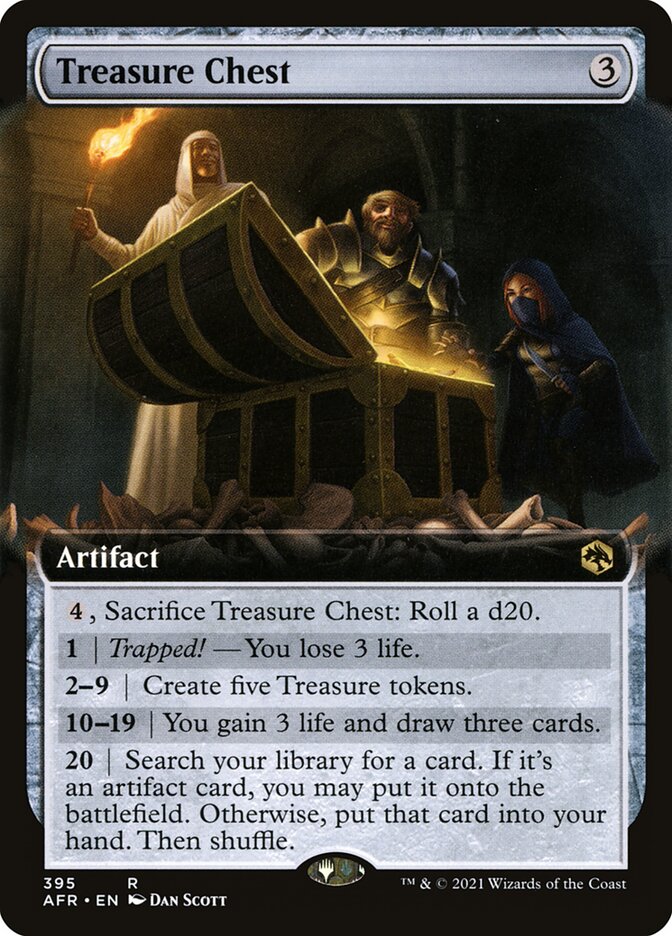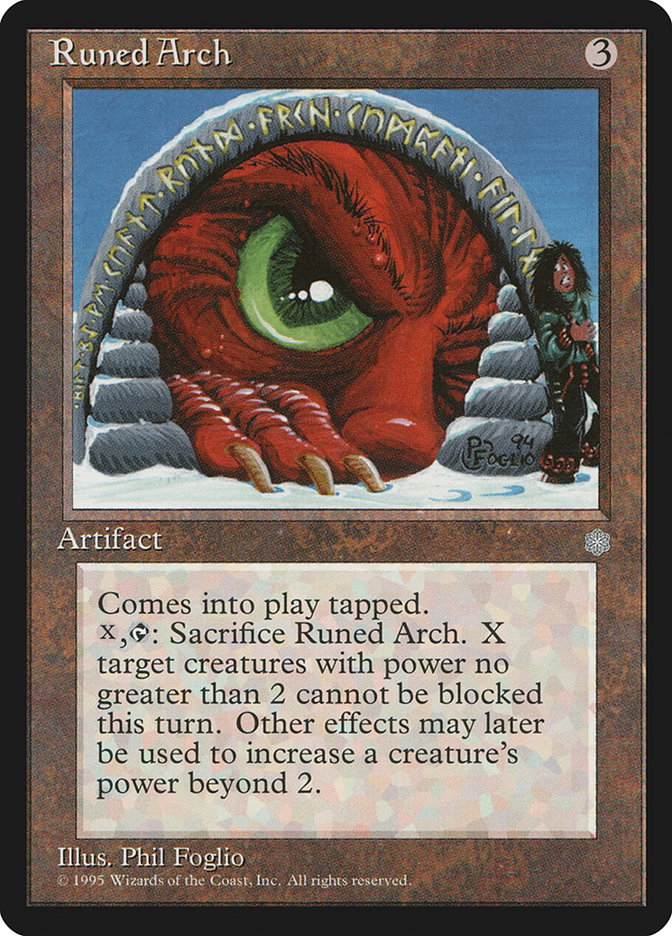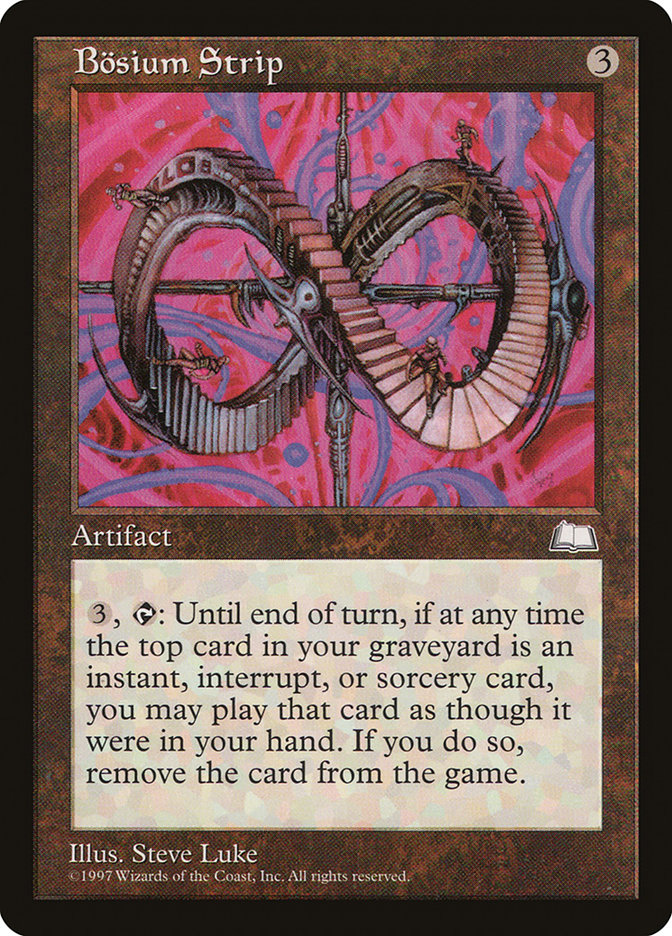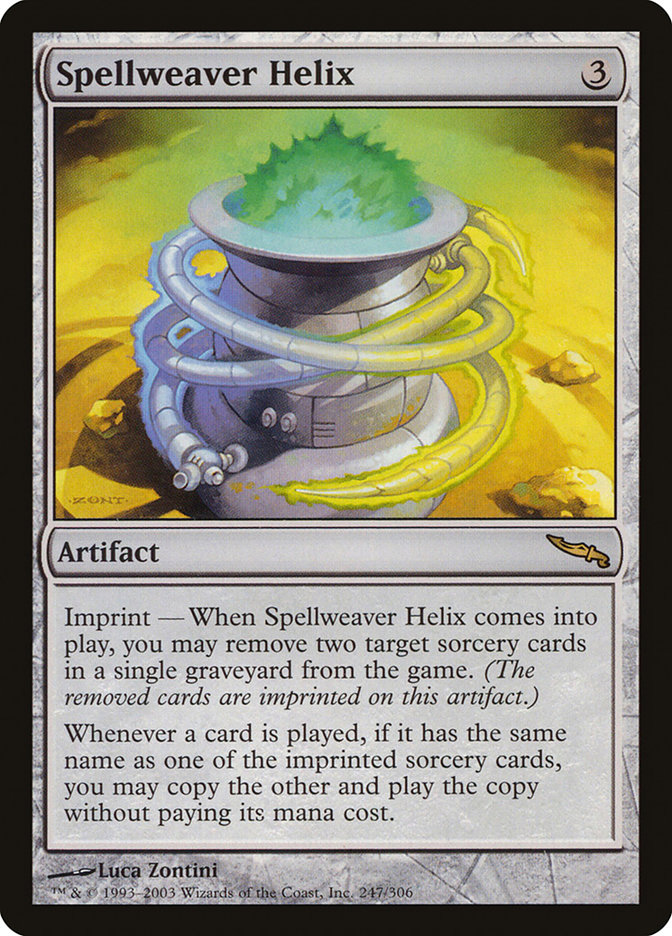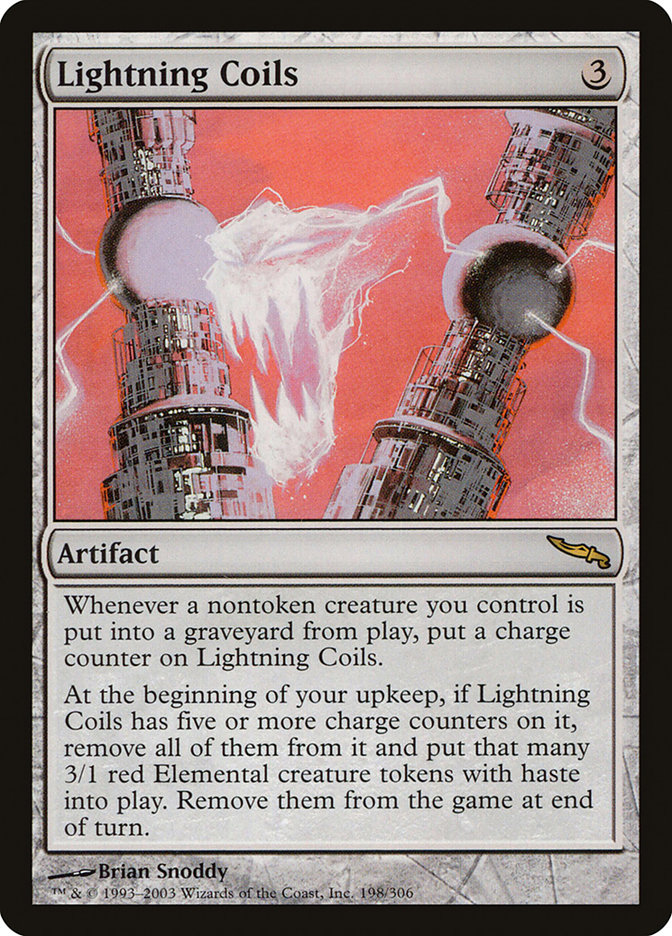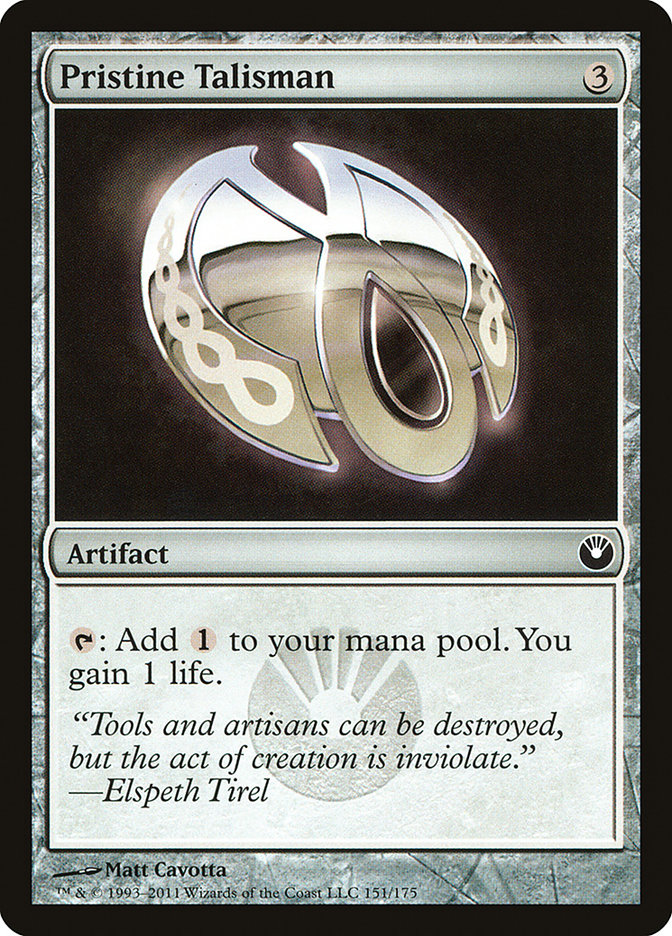Cofre del tesoro Carta MTG
| Colecciones da carta | Lanzado en 8 coleccionesVer todos |
| El coste de maná | |
| Costo de maná convertido | 3 |
| Rareza | Extraña |
| Tipo | Artefacto |
| Habilidades | Treasure |
Texto de la carta
{4}, sacrificar el Cofre del tesoro: Tira 1d20. 1 | ¡Hay una trampa — Pierdes 3 vidas. 2—9 | Crea cinco fichas de Tesoro. 10—19 | Ganas 3 vidas y robas tres cartas. 20 | Busca en tu biblioteca una carta. Si es una carta de artefacto, puedes ponerla en el campo de batalla. De lo contrario, pon esa carta en tu mano. Luego, baraja.
Cartas Similares
El Cofre del Tesoro, un artefacto intrigante en Magic: The Gathering, ofrece a los jugadores una oportunidad arriesgada pero potencialmente gratificante de lanzar los dados, literalmente. Esta característica tipo lotería es reminiscente de cartas como Ghirapur Orrery, que también enriquece a los jugadores con recursos adicionales. Sin embargo, el Cofre del Tesoro proporciona una gama más amplia de resultados posibles, incluyendo un tesoro de cartas o puntos de vida que le falta a Orrery.
Al comparar el Cofre del Tesoro con otras cartas basadas en la suerte, nos encontramos con Goblin Charbelcher. Charbelcher comparte la emoción de la imprevisibilidad pero se centra únicamente en el daño directo en contraposición a la tabla de botines versátil del Cofre del Tesoro. En cuanto a la generación de recursos, no se puede pasar por alto al Loto Dorado. Aunque no ofrece el elemento sorpresa, proporciona consistentemente maná de cualquier color, mientras que el Cofre del Tesoro podría, en parte, arriesgar su maná por una recompensa incierta.
Considerando todo, al comparar el Cofre del Tesoro con artefactos y mecanismos de MTG similares, ocupa una posición única. Intercambia una producción consistente por la emoción de la suerte in-game, lo cual para algunos jugadores, podría valer la pena lanzar los dados. El Cofre del Tesoro ciertamente abarca un amplio espectro en su apelación a jugadores que disfrutan de la imprevisibilidad y el potencial de grandes recompensas en su juego.
Cartas similares a Cofre del tesoro por color, tipo y coste de maná
Aspectos Positivos de la Carta
Ventaja de Cartas: La carta del Cofre del Tesoro ofrece el potencial de un impulso significativo en la ventaja de cartas. Descubrir los tesoros escondidos en su interior puede proveer a tu mano de una riqueza de nuevas opciones, asegurando que nunca te quedes corto en elecciones estratégicas.
Aceleración de Recursos: Esta carta no solo alimenta tus estrategias con recursos de mana inmediatos a través de fichas de Tesoro, sino que también allana el camino para jugadas contundentes en los turnos siguientes. Al aumentar tus recursos disponibles, puedes superar a tus oponentes y desplegar tus amenazas o defensas mucho más rápido.
Velocidad Instantánea: La versatilidad del Cofre del Tesoro se ve amplificada por su capacidad de ser activado a velocidad instantánea. Ya sea que estés respondiendo a la jugada de un adversario o simplemente optimizando tu uso de mana al final de su turno, la flexibilidad de esta carta es una ventaja estratégica considerable.
Aspectos Negativos de la Carta
Requisito de Descarte: Al utilizar el Cofre del Tesoro dentro del vasto universo de MTG, los jugadores deben ser conscientes del contratiempo potencial que conlleva su activación. Requerir un descarte puede ser un obstáculo estratégico, especialmente para aquellos con pocas cartas en la mano, forzando decisiones difíciles en la gestión de recursos.
Costo de Mana Específico: El costo de mana específico del Cofre del Tesoro puede limitar la flexibilidad del mazo. Dado que requiere una mezcla precisa de mana para utilizarse, los jugadores que deseen integrar esta carta en mazos multicolores pueden encontrarse luchando con problemas de consistencia en la base de mana. Esto puede llevar a posibles retrasos en su despliegue, minando la velocidad de juego.
Costo de Mana Comparativamente Alto: El costo para abrir los contenidos del Cofre del Tesoro es notable en comparación con otras opciones disponibles. Por los cuatro mana invertidos, los jugadores podrían aprovechar otros efectos más inmediatos o poderosos en el juego. Dada la abundancia de alternativas en MTG, el valor de gastar tales recursos en esta carta exige una cuidadosa consideración en contra de la estrategia única de cada mazo y el ritmo del meta actual.
Razones para Incluir en tu Colección
Versatilidad: El Cofre del Tesoro prospera en una variedad de mazos, con su capacidad para proporcionar aceleración de recursos y resultados de alto impacto. Es particularmente útil para mazos que se benefician tanto de la aleatoriedad como de la generación de riqueza.
Potencial de Combo: Esta carta crea una sinergia con estrategias que giran en torno a la manipulación de artefactos. Su capacidad para proporcionar fichas de Tesoro puede ser aprovechada para catapultar mazos impulsados por combo en jugadas poderosas o acabados.
Relevancia Meta: En una escena competitiva siempre cambiante, esta carta se adapta bien a la fluctuación de construcciones de mazos, ofreciendo soluciones contra configuraciones de control y mejorando las posibilidades del jugador en partidas prolongadas donde los recursos son cruciales.
Cómo Vencer
El Cofre del Tesoro es un artefacto intrigante que tiene el potencial de cambiar el rumbo de los juegos al ofrecer tanto aleatoriedad como generación de recursos. Comprender cómo neutralizarlo puede dar a los jugadores una ventaja. Los efectos de desencantar son tu principal herramienta contra los artefactos, con cartas como Naturalizar o el propio Desencantar siendo útiles para eliminarlo del campo de batalla antes de que pueda ser abierto. Alternativamente, contrarrestar el Cofre del Tesoro antes de que pueda tener un impacto asegura que la inversión de tu oponente fracase, por lo que mantener mana disponible para contrahechizos es una estrategia sólida.
También es beneficioso aplicar presión para restringir la capacidad de tu oponente para invertir mana de manera segura en la activación del Cofre del Tesoro. Estrategias agresivas que obliguen a los oponentes a responder a amenazas potentes pueden evitar que tengan el lujo de pagar el mana necesario para aprovechar las capacidades del Cofre del Tesoro. Además, las cartas que limitan la capacidad de activar habilidades pueden dejar el Cofre del Tesoro inerte, como Aguja de Pivote o Revocador de Fisrexiano. Por último, llevar un seguimiento del estado del tablero y mantener ventaja de cartas a menudo te pondrá en una posición donde el Cofre del Tesoro de tu oponente se convierte en un problema menor, ya que habrás acumulado recursos superiores o presencia en el tablero.
Recomendaciones de BurnMana
Las profundidades estratégicas de MTG ofrecen posibilidades infinitas, y la versátil carta del Cofre del Tesoro es una elección convincente para los jugadores que buscan agregar un elemento de azar y aceleración de recursos a sus mazos. Ya sea optimizando tus turnos o cambiando tu estrategia para superar a adversarios, cartas como el Cofre del Tesoro pueden marcar la diferencia. Animamos tanto a jugadores experimentados como a aquellos que aspiran a serlo a explorar el potencial de este intrigante artefacto dentro de sus colecciones. Para más estrategias, consejos y conocimientos para sacar el máximo provecho de tu experiencia de MTG, incluyendo cómo usar estas cartas dinámicas o contrarrestarlas efectivamente, adéntrate más con nosotros. Mejora tu juego y descubre todo el espectro de ofertas de MTG.
Donde comprar
Si estás buscando comprar una carta MTG Treasure Chest de un coleccione específico como Magic Online Promos and Magic Online Promos, existen varias opciones confiables que debes considerar. Una de las fuentes principales es tu tienda de juegos local, donde a menudo puedes encontrar paquetes de refuerzo, cartas individuales y mazos preconstruidos de colecciones actuales y pasadas. A menudo ofrecen el beneficio adicional de una comunidad donde puedes intercambiar con otros jugadores.
Para un inventario más amplio, particularmente de colecciones más antiguos, mercados en línea como TCGPlayer, Card Kingdom y Card Market ofrecen amplias selecciones y te permiten buscar cartas de colecciones específicos. Las plataformas de comercio electrónico más grandes como eBay y Amazon también tienen listados de varios vendedores, lo que puede ser un buen lugar para buscar productos sellados y hallazgos raros.
Además, el sitio oficial de Magic suele tener un localizador de tiendas y listas de minoristas para encontrar Wizards of the Productos con licencia costera. Recuerde comprobar la autenticidad y el estado de las cartas al comprarlas, especialmente a vendedores individuales en mercados más grandes.
A continuación se muestra una lista de algunos sitios web de tiendas donde puede comprar las Treasure Chest y otras cartas MTG:
 COMPRAR
COMPRAR BurnMana es un socio oficial de TCGPlayer
- eBay
- Card Kingdom
- Card Market
- Star City Games
- CoolStuffInc
- MTG Mint Card
- Hareruya
- Troll and Toad
- ABU Games
- Card Hoarder Magic Online
- MTGO Traders Magic Online
Ver productos MTG
Impresiones
La carta Treasure Chest Magic the Gathering se lanzó en 3 colecciones diferentes entre 2021-07-23 y 2021-07-23. Ilustrado por 2 diferentes artistas.
| # | Liberado | Nombre | Código | Símbolo | Número | Marco | Disposición | Borde | Artista |
|---|---|---|---|---|---|---|---|---|---|
| 1 | Magic Online Promos | PRM | 92836 | 2015 | Normal | Negra | Scott Murphy | ||
| 2 | Magic Online Promos | PRM | 92834 | 2015 | Normal | Negra | Dan Scott | ||
| 3 | 2021-07-23 | Adventures in the Forgotten Realms | AFR | 395 | 2015 | Normal | Negra | Dan Scott | |
| 4 | 2021-07-23 | Adventures in the Forgotten Realms | AFR | 397 | 2015 | Normal | Negra | Scott Murphy | |
| 5 | 2021-07-23 | Adventures in the Forgotten Realms Promos | PAFR | 252p | 2015 | Normal | Negra | Dan Scott | |
| 6 | 2021-07-23 | Adventures in the Forgotten Realms Promos | PAFR | 252s | 2015 | Normal | Negra | Dan Scott | |
| 7 | 2021-07-23 | Adventures in the Forgotten Realms Promos | PAFR | 252a | 2015 | Normal | Negra | Dan Scott | |
| 8 | 2021-07-23 | Adventures in the Forgotten Realms | AFR | 252 | 2015 | Normal | Negra | Dan Scott |
Legalidades
Formatos de Magic the Gathering donde Cofre del tesoro tiene restricciones
| Formato | Legalidad |
|---|---|
| Historicbrawl | Legal |
| Historic | Legal |
| Legacy | Legal |
| Oathbreaker | Legal |
| Gladiator | Legal |
| Pioneer | Legal |
| Commander | Legal |
| Modern | Legal |
| Vintage | Legal |
| Duel | Legal |
| Explorer | Legal |
| Penny | Legal |
| Timeless | Legal |
Reglas e información
La guía de referencia para las reglas de las cartas Cofre del tesoro de Magic: The Gathering proporciona las reglas oficiales, las erratas emitidas, así como un registro de todas las modificaciones funcionales que se han producido.
| Fecha | Texto |
|---|---|
| 23/07/2021 | Una habilidad que te indica que tires un dado también especificará qué hacer con el resultado de ese lanzamiento. La mayoría de las veces, esto se presenta en forma de una "tabla de resultados" en el texto de la carta. |
| 23/07/2021 | Un efecto que diga "elige un objetivo y luego tira un d20" o similar sigue utilizando el proceso normal de poner una habilidad en la pila y resolverla. Elegir objetivos es parte de poner la habilidad en la pila y tirar el d20 ocurre más tarde, a medida que se resuelve la habilidad. |
| 23/07/2021 | Los dados se identifican por el número de caras que tienen. Por ejemplo, un d20 es un dado de veinte caras. |
| 23/07/2021 | Los dados utilizados deben tener resultados igualmente probables y el lanzamiento debe ser justo. Aunque se recomiendan los dados físicos, se permiten sustitutos digitales, siempre que tengan el mismo número de resultados igualmente probables que se especifican en la instrucción original de lanzamiento. |
| 23/07/2021 | Si decides poner la carta en tu mano, no necesitas revelarla. |
| 23/07/2021 | Algunas habilidades, como la de Guía de Pixie y Clase Bárbara, reemplazan lanzar un dado con lanzar dados adicionales e ignorar el resultado más bajo. Los resultados ignorados no se consideran para el efecto que te instruyó a lanzar un dado, y no activan habilidades. Para todos los efectos, una vez que determinas cuáles dados cuentan, los dados adicionales nunca se lanzaron. |
| 23/07/2021 | Algunos efectos indican que debes volver a lanzar. Esto utilizará el mismo número y tipo de dados que el lanzamiento original, y ese lanzamiento utilizará el mismo conjunto de posibles resultados. |
| 23/07/2021 | Algunos efectos pueden modificar el resultado de tirar un dado. Esto puede ser parte de la instrucción para tirar un dado o puede provenir de otras cartas. Cualquier cosa que haga referencia al "resultado" de tirar un dado está buscando el resultado después de estas modificaciones. Cualquier cosa que esté buscando el "resultado natural" está buscando el número mostrado en la cara del dado antes de estas modificaciones. |
| 23/07/2021 | Las instrucciones para lanzar un dado y el efecto que ocurre debido al resultado forman parte de la misma habilidad. Los jugadores no tienen la oportunidad de responder a la habilidad después de conocer el resultado del lanzamiento. |
| 23/07/2021 | El "en caso contrario" en la última habilidad se refiere a si lo pones o no en el campo de batalla, no a si es o no una carta de artefacto. Puedes ponerlo en tu mano incluso si es una carta de artefacto. |
| 23/07/2021 | Los eventos de torneo tienen reglas más específicas respecto a los dados y el lanzamiento de dados. Para obtener más información, consulte la versión más reciente de las Reglas del Torneo de Magic en https://wpn.wizards.com/es/document/magic-gathering-tournament-rules. |
| 23/07/2021 | Durante una partida de Planechase, al lanzar el dado de plano, se desencadenará cualquier habilidad que se active cada vez que un jugador lance uno o más dados. Sin embargo, cualquier efecto que haga referencia a un resultado numérico ignorará el lanzamiento del dado de plano. |
